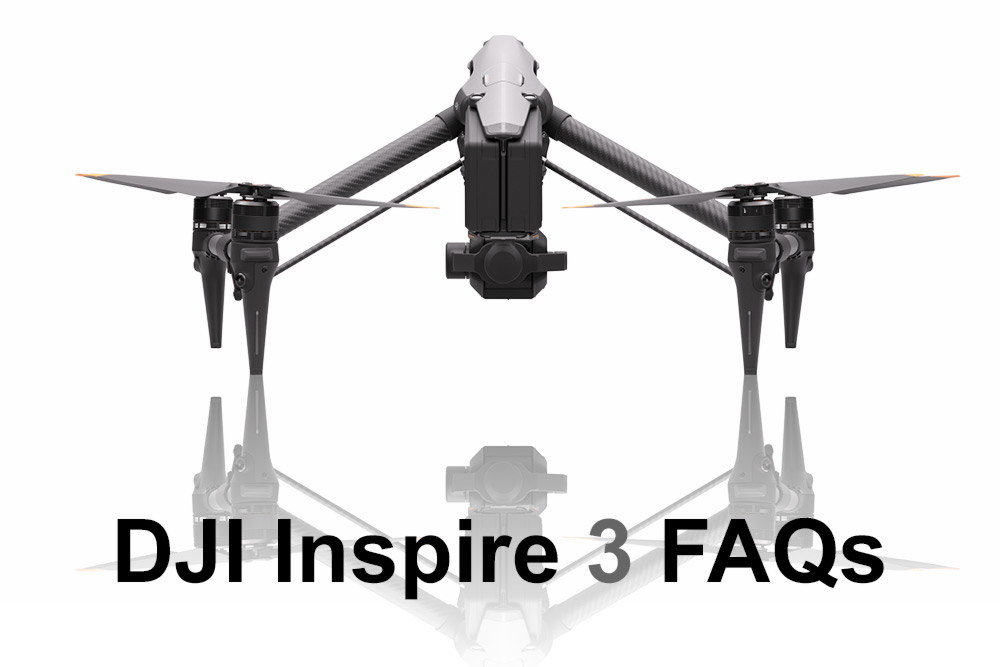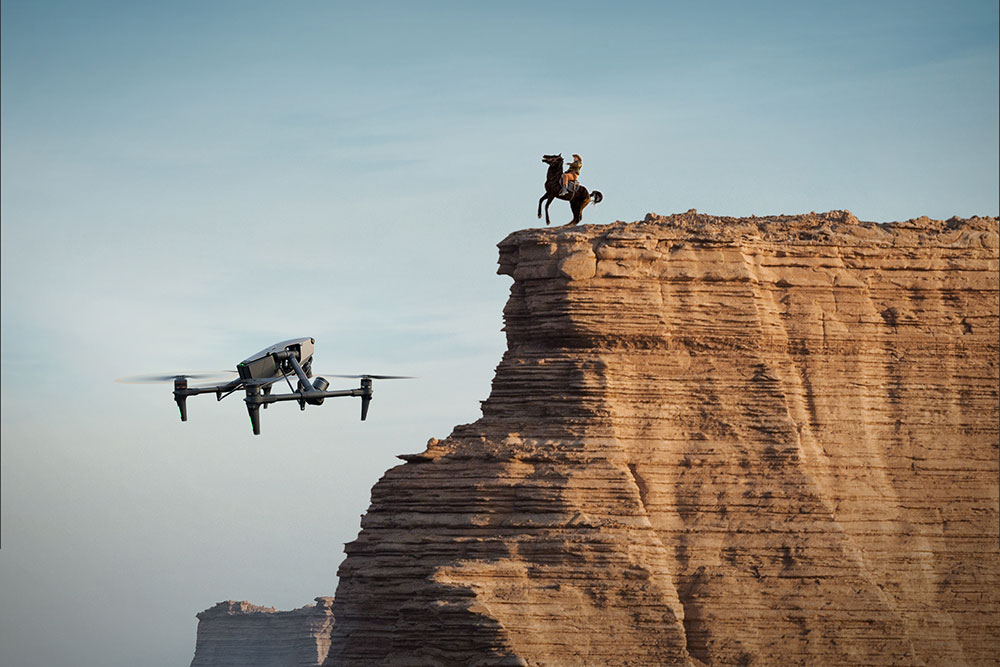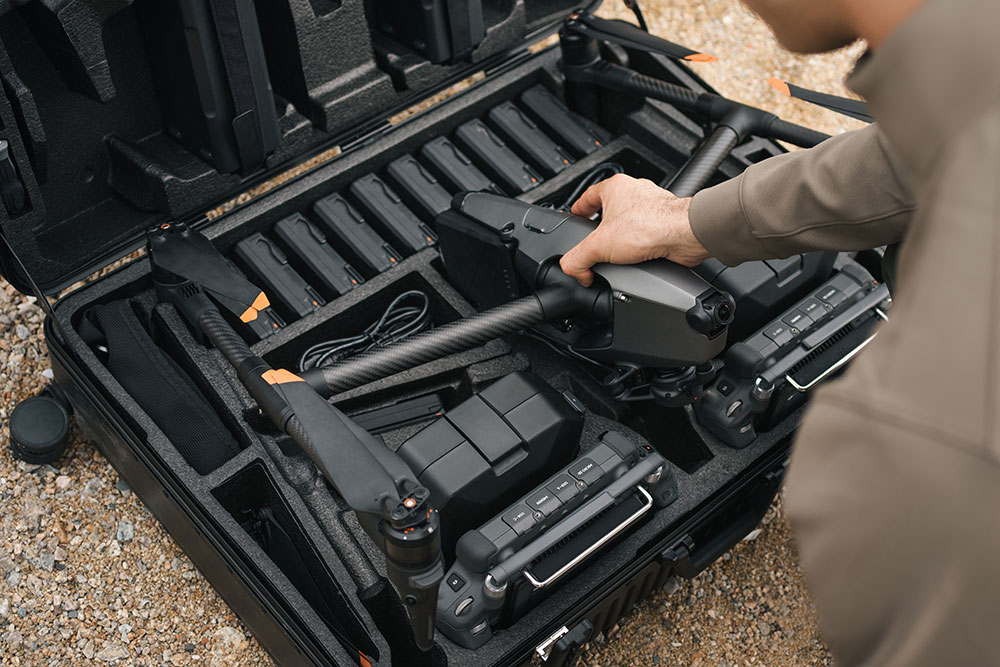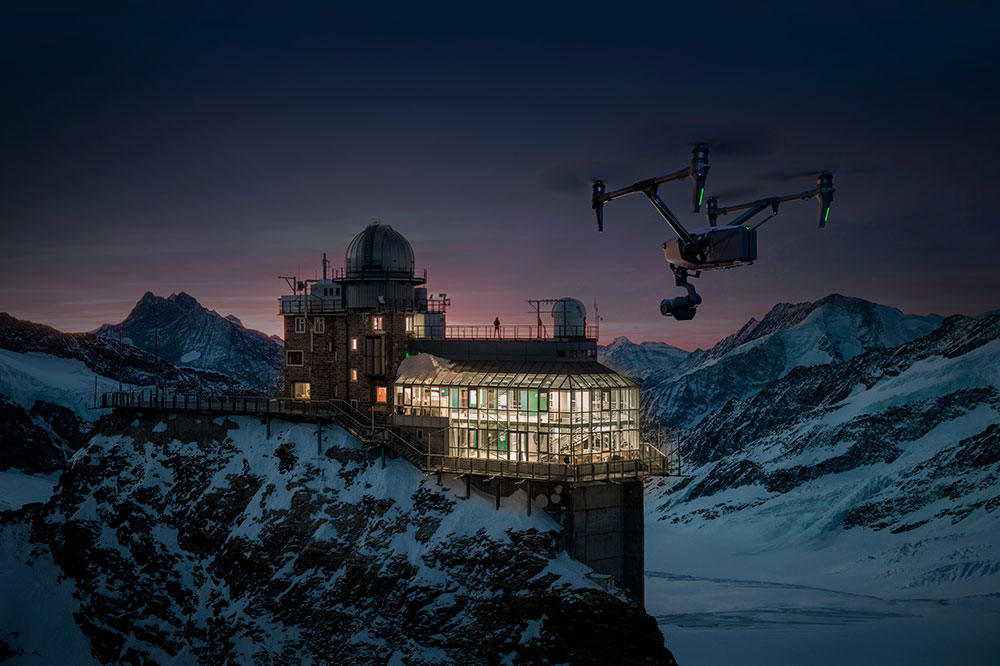- Call us: 01444 237070
- Contact Us
- Stores
- Sign In / Register
-
- Back
- Used Cameras
- Used Accessories
- Used Lenses
- Used Video
- Used Film Equipment
- Used Stock Alert
- Used Blank Test
- Sell or Part Exchange
- Used Clearance
- Recently Added Used Equipment
- Park Picks
- All Used Black Friday Deals
- Faulty
- Trade-In
- Blog
- New in
- Call us
- Contact us
- Stores
- Sign in
- Categories
- Tips & Inspiration
- Reviews
- News
- Events
- Features
- Buying Guides
- Competitions
DJI Inspire 3 FAQs
The DJI Inspire 3 is one of the few truly affordable professional drones for cinema productions, arriving six years after its predecessor, following a lot of hype and much anticipation. Our DJI Inspire 3 FAQs have everything you need to know about the new 8K cinema-ready drone from DJI, which arrives packed with updated tech for pro aerial filmmakers.

These FAQs come directly from DJI in order to address some of the most commonly asked questions about the new camera drone, remote controller and updated video transmission system.
Whether you’re a solo creator or part of a production team the Inspire 3 arrives with upgraded features to help you create the most compelling aerial shots more easily than ever before. So let’s get stuck in.
DJI Inspire 3 Aircraft FAQs
DJI has updated virtually every aspect of the aircraft itself, which offers improved manoeuvrability and obstacle avoidance, from a smaller, sleeker design. DJI Inspire 3 also features a full-frame 8K imaging system, O3 Pro video transmission and control system and efficient full-scenario operation. Compared with DJI Inspire 2, the image quality and operation efficiency of Inspire 3 is significantly improved for greater creative freedom and an enhanced experience.
|
Max horizontal speed |
94 kph, which is measured when flying in a windless environment with gimbal camera and lens attached to the aircraft and without other accessories. |
|
What is DJI Inspire 3 max takeoff weight? |
Approx. 4310 g |
|
What is DJI Inspire 3 max wind resistance? |
12 m/s during takeoff/landing and 14 m/s during flight, which is measured when flying in a windless environment at sea level, with gimbal camera and lens attached to the aircraft and without other accessories. |
|
Max flight time? |
Inspire 3’s max hovering time is approx. 25 minutes, and the max forward flying time is approx. 28 minutes. The max hovering time was measured when hovering in a windless environment at sea level with gimbal camera and lens attached to the aircraft and without other accessories, with landing gear raised, and recording 4K/24fps H.264 (S35) video until the battery reached 0%. The forward flying time was measured when flying forward at a constant speed of 36 kph in a windless environment at sea level, with gimbal camera and lens attached to the aircraft and without other accessories, with landing gear lowered and recording 4K/24fps H.264 (S35) video until the battery reached 0%. This data is for reference only. Please refer to the actual values in the app. |
|
Does Inspire 3 have an obstacle sensing system? |
Yes. Inspire 3 is equipped with an omnidirectional visual sensing system to detect obstacles in all directions, providing comprehensive protection for flying. Obstacle sensing is disabled while the landing gear is in the process of being raised or lowered. When the landing gear is down, there are obstacle-avoidance blind spots at the front-left and front-right areas of the aircraft of approximately 20°. |
|
What are the gimbal camera’s largest tilt and pan angles and how do you achieve them? |
When the landing gear of DJI Inspire 3 is raised, it supports 360° pan shooting obstruction-free. When the landing gear is lowered and the gimbal camera faces forward, it can achieve 80° tilt shooting obstruction-free. |
|
DJI Inspire 3 dimensions |
When the landing gear is raised, the diagonal distance is approx. 695 mm; When the landing gear is lowered, the diagonal distance is approx. 685 mm; Travel Mode Dimensions 500.5 x 709.8 x 176 mm (length x width x height). |
|
Can you control the FPV camera tilt axis? |
Yes. When the remote controller is using the default settings, turn the wheel on the upper left to control the tilt axis. |
DJI Inspire 3 Camera FAQs
Once again DJI has redesigned the gimbal camera from the ground up, which means it’s not backwards compatible, but does offer the latest an all-new quick-release port and vastly improved imaging capabilities.
|
Does Inspire 3 include a gimbal camera? |
Yes. It comes with the DJI Zenmuse X9-8K Air, which is a full-frame gimbal camera. |
|
Which lenses are compatible with Zenmuse X9-8K Air? |
|
|
What major upgrades does the Zenmuse X9-8K Air image sensor have, compared to the Zenmuse X7? |
Zenmuse X9-8K Air is equipped with a full-frame image sensor that can record video at up to 8K RAW. It supports 14+ stops of dynamic range and dual native ISO to retain more details, meeting the needs of a wide variety of cinematography scenarios. |
|
What is the difference between the Zenmuse X9-8K Air and the Zenmuse X7 lens mount? |
Zenmuse X9-8K Air has added a lens locking lever. After mounting the lens, tighten the locking lever to secure the lens and further reduce shake. Before detaching the lens, make sure that the lens locking lever is in the unlocked position. |
|
Is DJI Inspire 3 compatible with other Zenmuse gimbal cameras? |
No. Inspire 3 adopts an all-new gimbal camera quick-release port that currently supports only the full-frame Zenmuse X9-8K Air gimbal camera. |
|
Can I use Zenmuse X9-8K Air independently from DJI Inspire 3? |
No. Zenmuse X9-8K Air is only compatible with DJI Inspire 3. To get the same-level image quality on a ground-based platform, DJI Ronin 4D is recommended. |
|
Can I use Zenmuse X9-8K Air on DJI Inspire 2? |
No. Zenmuse X9-8K Air adopts an all-new gimbal camera quick-release port, so it cannot be used on DJI Inspire 2. |
|
Are the CinemaDNG and Apple ProRes RAW codecs supported by the Zenmuse X9-8K Air included when I purchase the DJI Inspire 3? |
No. Both license keys are sold separately. |
|
Do lenses compatible with Zenmuse X9-8K Air support third-party filters? |
Yes. For 18 mm lens, use 55 mm filter. For 24 mm, 35 mm and 50 mm lenses; use filters with a diameter of 46 mm, weight between 10-12 g, and thickness (excluding the screw) within 4.4 mm. |
Remote Controller and Video Transmission FAQs
In a major upgrade, DJI Inspire 3 adds the all-new O3 Pro video transmission system, which supports simultaneous video transmission of the gimbal camera and the FPV camera. These benefit from improved transmission, lower latency and automatic live feed adjustment.
|
What are the key DJI Inspire 3’s video transmission system features? |
DJI Inspire 3 adopts the all-new O3 Pro video transmission system, which supports simultaneous video transmission of the gimbal camera and the FPV camera. Both the gimbal camera and FPV camera support HD, 1080p/60fps live feeds with latency as low as 90 ms. 4K/30fps UHD live feeds are also supported to meet the needs of monitoring and live-streaming on set. The lowest latency of the gimbal camera was measured when recording 4K/60fps ProRes RAW video. The lowest latency of the FPV camera was measured with strong video transmission signals. |
|
How do you enable 4K/30fps live feeds on DJI Inspire 3? |
4K/30fps live feeds are only available when recording video at 30 fps or below. Tap the settings button '…' on the right of the top menu bar on the DJI Pilot 2 app and enable this live feed specification on the image transmission settings page. Since the 4K/30fps video transmission is highly dependent on the video transmission bitrate. When the video transmission bitrate is lower than 10Mbps, it is recommended to manually adjust the resolution to 1080p (auto adjustment not supported). When the communication quality is poor, the frame rate of the FPV camera live feeds and the gimbal camera will automatically adjust in order to improve the display quality. After the communication quality improves, the frame rate will automatically adjust to the default frame rate. In order to ensure flight safety, when the communication quality is poor, priority will be given to the live feed quality of the FPV camera. When enabling 4K/30fps live feeds, it is normal for the video transmission distance to be reduced. Check the DJI Inspire 3 User Manual for more details. |
|
Does DJI Inspire 3 support dual remote controllers at the same time? |
Yes. In the new dual-control mode, two remote controllers can receive live feeds and control the drone independently, so the pilot and gimbal operator can be at different positions on set during flight. Check the DJI Inspire 3 User Manual for more details. |
|
What are the max video transmission distances of the gimbal camera and the FPV camera in single control mode vs dual-control mode? |
Single control mode: FPV Camera: approx. 15 km (FCC), 8 km (CE/SRRC/MIC). Gimbal Camera (1080p/60fps live feeds): approx. 13 km (FCC), 7 km (CE/SRRC/MIC). Gimbal Camera (4K/30fps live feeds): approx. 5 km (FCC), 3 km (CE/SRRC/MIC). Dual-control mode: FPV Camera: approx. 12 km (FCC), 6.4 km (CE/SRRC/MIC). Gimbal Camera (1080p/60fps live feeds): approx. 11.2 km (FCC), 5.6 km (CE/SRRC/MIC). Gimbal Camera (4K/30fps live feeds): approx. 4 km (FCC), 2.4 km (CE/SRRC/MIC). Measured in an unobstructed outdoor environment free of interference, with gimbal camera and lens attached to the aircraft and without other accessories. The above data shows the farthest communication range for one-way, non-return flights under each standard. During your flight, please pay attention to reminders in the app. |
|
Does DJI Inspire 3 support the DJI High-Bright Remote Monitor? |
Yes. DJI High-Bright Remote Monitor can pair directly with Inspire 3 to receive live feeds, and can even control gimbal and focus when the Ronin 4D Hand Grips are attached. HDMI and SDI ports on the remote monitor can also output live feeds to other monitoring devices. |
|
What advantages does the DJI Inspire 3 remote controller have? |
DJI Inspire 3 comes with a professional-level remote controller, the DJI RC Plus, which has a built-in 7-inch 1,200-nit high-bright screen to provide an extraordinary outdoor monitoring experience. It also features an HDMI out port, along with several buttons and dials that enable fast and intuitive operation. When used together, the built-in battery of RC Plus plus and an external battery provide an operating time of up to 6 hours. RC Plus also supports battery hot-swapping for more convenience and shooting efficiency. The included professional accessories such as a strap and waist support and the new DJI Pilot 2 app meet the monitoring requirements of gimbal operators and DPs. DJI RC Plus provides cinematographers with an exceptional monitoring experience and a high level of operating efficiency. |
|
Are the remote controllers of DJI Inspire 3 and DJI Inspire 2 interchangeable? |
No. DJI Inspire 3 comes with a DJI RC Plus, which improves control experience and delivers longer battery life. It also supports hot-swapping and the new DJI Pilot 2 app to enhance creative efficiency. |
|
What is the operating time of a fully charged DJI RC Plus? How long does it take to fully charge? |
When using only the built-in battery, DJI RC Plus provides a max operating time of approx. 3.3 hours. Using the built-in battery in addition to an external battery provides a max operating time of approx. 6 hours. It takes approx. 2 hours to fully charge the built-in battery. Charging time when using the built-in and external batteries together:
It is recommended to use the included battery charging hub and the USB-C to USB-C high-speed data cable for optimal charging. The charging time may vary according to ambient temperature. |
|
Does DJI RC Plus come with a screen included? |
Yes. DJI RC Plus comes with a 7.02-inch LCD touchscreen with a resolution of 1920 x 1200 pixels and high brightness of 1,200 nits. |
Battery and other features FAQs
Batteries are an integral element of the Inspire 3 and DJI has developed a hot-swappable, high-capacity intelligent system for the Inspire 3. As well as updated power tech, DJI implemented RTK positioning, timecode sync and other useful features for aerial filmmakers.
|
Why am I unable to charge two batteries simultaneously with the battery charging hub? |
When the remaining battery levels of the paired batteries are not the same, the battery charging hub will charge the one with less power first. When the batteries show the same power, the battery charging hub will charge the paired batteries simultaneously. |
|
Why are batteries paired? |
Paired batteries will charge and discharge together to maximise flight time and battery life and to optimise the flight experience. Unpaired batteries can still be used, but this may affect the flight time and battery life. |
|
How do I pair batteries? |
After unboxing, the two batteries can be marked with a battery pairing sticker, or pair the two batteries with similar cycle counts in the DJI Pilot 2 app. |
|
How do I know if the batteries are correctly mounted? |
When the battery is inserted in place, the battery release will make a clicking sound. If the battery is not mounted correctly, the DJI Pilot 2 app will prompt 'Battery not properly installed.' |
|
Can I take off with the aircraft if the two batteries have different power levels? |
When the battery temperature is higher than 5° C (41° F), the aircraft can take off as long as the power discrepancy is less than 21% and the voltage discrepancy is less than 0.7 V. When the battery temperature is lower than 5° C (41° F), the aircraft can take off when the power discrepancy is less than 8% and the voltage discrepancy is less than 0.1 V. The aircraft cannot take off if the aforementioned conditions are not met, and the DJI Pilot 2 app will prompt that the power discrepancy is too large. |
|
How should I store the batteries if I am not using them for a long duration of time? What is the max storage time? |
It is recommended to store the batteries separately in a dry environment at room temperature of approx. 25° C (77° F). Do not insert the battery into the aircraft or the charging hub for storage. It is recommended to fully charge and discharge the batteries every three months in order to maintain battery health. Battery self-discharge will be triggered if the battery level is higher than 60%. Discharging the battery level to 60% can extend battery life. To store a fully charged battery, set the battery self-discharge time to 1 day and have it discharge to 60% quickly. |
|
How do I update the firmware of the batteries? |
You can update the batteries in the following two ways:
|
|
Does DJI Inspire 3 support battery hot swapping? |
Yes. When replacing the battery, the aircraft does not need to power off. |
|
Is DJI Inspire 3 compatible with the TB50 battery? |
No. The DJI Inspire 3 aircraft only supports TB51 batteries. |
|
Can I charge a TB50 battery with the battery charging hub of DJI Inspire 3? Can I charge DJI Inspire 3’s TB51 batteries using the TB50 battery charging hub and the TB50 battery station? |
No. TB51 has different charging power compared to TB50. |
|
Can I take DJI Inspire 3’s batteries in carry-on baggage when boarding an airplane? |
Yes. The capacity of a DJI Inspire 3 Intelligent Battery is 4280 mAh and the energy is 98.8 Wh. Most aviation companies regulate that batteries under 100 Wh can be transported in carry-on baggage. Regulations regarding LiPo batteries in carry-on baggage can vary by country and region. Consult your local airline and the relevant authorities of the departure and destination locations. |
|
Does DJI Inspire 3 come with a charger included? How long does it take to fully charge the batteries? |
DJI Inspire 3 comes with an all-new battery charging hub, which supports three charging modes. In Fast charge mode, it takes only 35 minutes to charge two batteries to 90%. In Standard mode, it takes 55 minutes to fully charge two batteries. In Silent mode, it takes approx. 80 minutes to fully charge two batteries. Tested at a room temperature of 25° C (77 °F) and in a well-ventilated environment. In Fast mode, each battery pair is charged to 90% in sequence, and then eight batteries are charged together to 100%. |
|
Do I need to detach the propellers before putting DJI Inspire 3 into the trolley case? |
The new foldable propellers do not need to be removed from the aircraft when placing Inspire 3 inside the trolley case for transportation or storage. Check the official tutorial for more details. For long-duration transportation or shipping, it is recommended to remove the propellers and place them into the corresponding storage compartment of the trolley case. |
|
What is the default password of the trolley case? How do I change the password? |
The default password of the trolley case is 000. To change the password, follow the steps below: 1. Toggle the resettable switch on the rear of the lock to SET. 2. Adjust the dials to set a personal combination code. 3. Toggle the resettable switch to OFF to finish setting. |
|
What are the advantages of Inspire 3’s high-precision RTK positioning technology? |
High-precision RTK positioning technology empowers DJI Inspire 3 to achieve centimeter-level positioning, which not only makes flying more stable, but also ensures more accurate flight-route planning and execution with the new Waypoint Pro feature. DJI Inspire 3 also supports use with an RTK base station and network RTK. You can choose flexibly according to the application scenario. |
|
Does DJI Inspire 3 support timecode synchronization? |
Yes. Through the 3.5mm port on the aircraft, you can sync timecode between equipment in the air and on the ground. When dealing with abundant footage from multiple cameras, timecode sync makes the editing process significantly more simplified and efficient. |
|
What is the model of the DJI Inspire 3 propellers? |
Standard propellers: DJI 1671 High altitude propellers: DJI 1676 |
|
Does DJI Inspire 3 come with high altitude propellers? |
No. High altitude propellers are sold separately and are used only when the altitude is higher than 3000 m. |
|
Does DJI Inspire 3 come with an external DJI PROSSD 1TB included? |
One is included with the Inspire 3 combo. |
|
Can I use the DJI PROSSD 1TB of DJI Inspire 3 on DJI Ronin 4D? |
Yes. |
|
What other accessories does DJI Inspire 3 support? |
It supports a range of accessories, including DJI Master Wheels, DJI Three-Channel Follow Focus, DJI Ronin 4D Hand Grips, and DJI Transmission. |
What’s included in the DJI Inspire 3 Combo?
The combo has everything you need, aside from one of the four proprietary DL mount lenses and includes:
- 1 x Inspire 3 Aircraft
- 1 x RC Plus (Inspire 3)
- 1 x Double-Headed Screwdriver
- 1 x USB-C to USB-C High-Speed Data Cable
- 1 x USB-C to USB-A Data Cable
- 6 x TB51 Intelligent Battery
- 1 x TB51 Intelligent Battery Charging Hub
- 1 x TB51 Intelligent Battery Charging Hub AC Cable
- 1 x TB51 Intelligent Battery Paired Batteries Sticker
- 3 x Inspire 3 Foldable Quick-Release Propellers (Pair)
- 1 x PROSSD 1TB
- 1 x Inspire 3 Trolley Case
- 1 x RC Plus Strap
- 1 x RC Plus Waist Support
- 3 x Documents
- 1 x Zenmuse X9-8K Air Gimbal Camera
- 1 x Zenmuse X9-8K Air Gimbal Camera Case
- 1 x DL Mount Lens Cap
- 1 x X9 Gimbal Base Cap
- 1 x Lens Carrying Box (18/24/35/50mm)
- 2 x Inspire 3 Gimbal Rubber Dampers
Inspire 3 arrives with significant improvements to the aircraft and aerial imaging capabilities and joins a large ecosystem of drone accessories to maximise your creative potential.
Secure your DJI Inspire 3 Combo today and start creating stunning aerial cinematography with one of the most advanced camera drones available.
Share this post:
By Nick Dautlich on 13/04/2023
Nick Dautlich
Senior Content Writer and Product Reviewer
Nick Dautlich is the Senior Content Writer and Product Reviewer at Park Cameras, with over 15 years of photography experience. A Sony Imaging Professional and expert reviewer, Nick has worked with major brands such as Canon, Sony and Nikon. His work is also featured on Vanguard World UK’s website, Capture Landscapes, and Shutter Evolve. Nick’s photography includes National Trust projects and magazine covers and he is passionate about landscapes and storytelling. Nick also enjoys hiking and teaching his children about nature. Learn more on his profile page.

Trade in your old equipment
Fast and easy trade in service ensures your old gear is collected efficiently and you are paid quickly! It's very simple to trade in your unwanted photography gear. Just head over to our dedicated Sell or Part Exchange page, fill out the details, and we'll get back to you with an offer for your old gear. Take the cash, or put it towards the cost of your new gear. It's up to you! Find out more
sign up to the newsletter
Keep up to date on the latest photography news, events and offers. Sign up now



